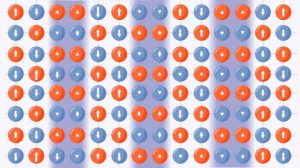The team used a straightforward two dimensional model, the Hubbard model, and hundreds of hours of supercomputer effort to get results that are close to those found in experiments.
“There was tremendous excitement when cuprate superconductors were discovered, but no understanding of why they remain superconductive at such high temperatures,” said Flatiron scientist Shiwei Zhang. “I think it’s surprising to everybody that almost 40 years later, we still don’t quite understand why they do what they do.”
The model treats the material as a rectangular grid of electrons with spin up or spin down, doped with extra electrons or holes.
Calculations are complex, according to the Institute, because the electrons are entangled
Such straightforward models can spark a deeper understanding of physics, according to fellow researcher Ulrich Schollwöck, a professor at Ludwig-Maximilians-Universität München. “The idea in physics is to keep the model as simple as possible because it’s difficult enough on its own,” he said. “So in the beginning we studied the simplest version imaginable.”
That study was a few years ago and revealed stripy patterns of spin, but not superconductor behaviour.
Now the whole thing has been repeated at the next level of complexity up, which added the freedom for electrons to make diagonal hops across the matrix.
And superconductivity appeared.
“By showing that the humble Hubbard model can describe cuprate superconductivity, [the researchers] prove its worth as a platform for understanding why and how superconductivity emerges,” according to the Institute.
The work is described in the Science paper ‘Coexistence of superconductivity with partially filled stripes in the Hubbard model‘.
The Flatiron Institute and Ludwig-Maximilians-Universität München worked with the College of William and Mary, National Sun Yat-sen University, Shanghai Jiao Tong University and the University of California Irvine.
 Electronics Weekly Electronics Design & Components Tech News
Electronics Weekly Electronics Design & Components Tech News



